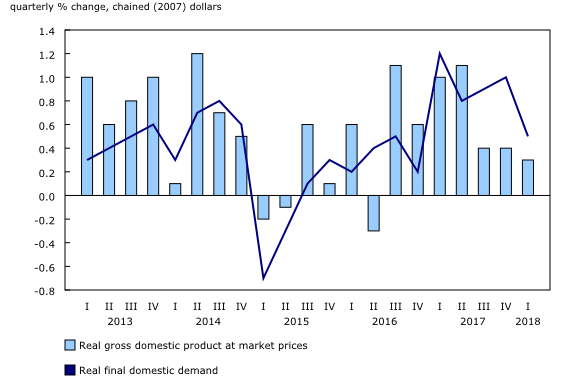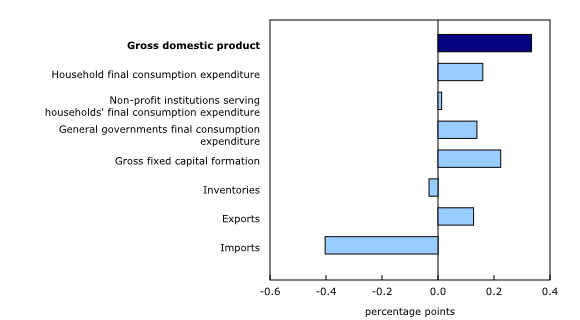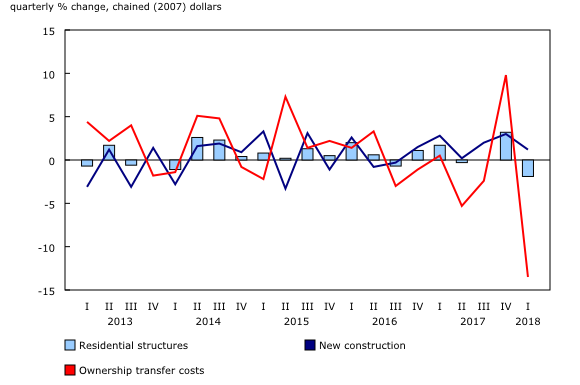Gross domestic product, income and expenditure, first quarter 2018
Archived Content
Information identified as archived is provided for reference, research or recordkeeping purposes. It is not subject to the Government of Canada Web Standards and has not been altered or updated since it was archived. Please "contact us" to request a format other than those available.
Released: 2018-05-31
Real gross domestic product (GDP) grew 0.3% in the first quarter, following an increase of 0.4% in each of the previous two quarters. Final domestic demand rose by 0.5%.
Growth was moderated by a deceleration in household spending, lower exports of non-energy products and a decline in housing investment (-1.9%).
Household spending grew 0.3%, the slowest pace since the first quarter of 2015. Growth was driven by increased outlays on services (+0.5%). Household spending on goods was unchanged, following 11 consecutive quarterly increases.
Export volumes rose 0.4% after increasing 1.0% in the fourth quarter of 2017. Exports of crude oil and crude bitumen (+9.9%) largely contributed to the gains. Exports of services grew 1.7% in the first quarter, following a 1.3% increase in the previous quarter.
Business investment in machinery and equipment (+4.2%) and intellectual property products (+3.3%) increased at a faster pace than in the fourth quarter of 2017.
Expressed at an annualized rate, real GDP was up 1.3% in the first quarter. In comparison, real GDP in the United States grew 2.2%.
Housing investment falls
Investment in housing fell 1.9% in the first quarter, the largest decline since the first quarter of 2009, due to a drop in ownership transfer costs (-13.5%). Lower resale activity coincided with new mortgage stress measures introduced nationwide in January. Business outlays on new construction slowed to 1.2% growth, while renovations increased 1.4%.
Consumer spending decelerates
Household final consumption expenditure decelerated for a third consecutive quarter, slowing to 0.3% in the first quarter. Outlays on goods were virtually unchanged, while outlays on services grew 0.5%.
Housing-related expenses (housing, water, electricity, gas and other fuels) increased 0.8% and outlays on insurance and financial services grew 1.5%. Purchases of vehicles were flat in the first quarter, following strong growth in 2017.
Non-residential investment increases
Investment in machinery and equipment rose 4.2% in the first quarter, with medium and heavy trucks, buses and other motor vehicles (+12.5%) and industrial machinery and equipment (+3.9%) contributing to the growth. Intellectual property products rose 3.3%, as mineral exploration and evaluation (+8.0%) rebounded and software (+3.2%) accelerated. Investment in non-residential structures increased 1.5%.
Export growth slows
Growth in export volumes slowed to 0.4% in the first quarter, following a 1.0% gain in the previous quarter. The first quarter growth was driven by exports of services (+1.7%), including commercial (+2.2%) and travel (+1.7%) services.
Exports of goods edged up 0.2%, as growth in crude oil and crude bitumen (+9.9%) and motor vehicles and parts (+2.0%) was partially offset by lower exports of refined petroleum energy products (-18.8%).
Imports rose by 1.2% in the first quarter, with similar increases in goods and services.
Growth in imports of goods was led by passenger cars and light trucks (+5.9%), tires, motor vehicle engines and parts (+6.0%) and basic chemicals and industrial chemical products (+8.6%).
Imports of services rose 1.1%, as those of commercial (+1.3%), transportation (+1.4%) and travel (+0.6%) services all increased.
Inventories continue to accumulate
Businesses added $15.2 billion to their inventories in the first quarter, following an accumulation of $15.9 billion in the previous quarter. Wholesalers (+$5.4 billion), manufacturers (+$4.0 billion) and retailers (+$2.6 billion) all added to their stocks. Farm inventories grew by $567 million, compared with an accumulation of $2.7 billion in the fourth quarter of 2017. The economy-wide stock-to-sales ratio increased from 0.760 to 0.765 in the first quarter.
Economy-wide income increases
Real gross national income (the real purchasing power of income earned by Canadian-owned factors of production) increased 0.5% in the first quarter, outpacing real GDP growth for a third consecutive quarter.
The GDP implicit price index, representing the price of goods and services produced in Canada, rose 0.3%. Export prices (+1.0%) increased at a faster pace than import prices (+0.7%), leading to slightly improved terms of trade.
Gross operating surplus (in nominal terms) grew 0.7%, led by increased earnings of energy producers.
Household disposable income rose by 0.8%, as compensation of employees was up 1.0%. The household saving rate edged down to 4.4%, with household spending slightly outpacing disposable income in the first quarter.
Sustainable Development Goals
On January 1, 2016, the world officially began implementation of the 2030 Agenda for Sustainable Development—the United Nations' transformative plan of action that addresses urgent global challenges over the next 15 years. The plan is based on 17 specific sustainable development goals.
Gross domestic product, income and expenditure is an example of how Statistics Canada supports the reporting on the Global Goals for Sustainable Development. This release will be used in helping to measure the following goals:


Note to readers
For information on seasonal adjustment, see Seasonally adjusted data – Frequently asked questions.
Percentage changes for expenditure-based statistics (such as personal expenditures, investment, exports and imports) are calculated from volume measures that are adjusted for price variations. Percentage changes for income-based and flow-of-funds statistics (such as labour income, corporate profits, mortgage borrowing and total funds raised) are calculated from nominal values; that is, they are not adjusted for price variations.
There are two ways of expressing growth rates for gross domestic product (GDP) and other time series found in this release:
- Unless otherwise stated, the growth rates in this release represent the percentage change in the series from one quarter to the next, such as from the fourth quarter of 2017 to the first quarter of 2018.
- Quarterly growth can be expressed at an annual rate by using a compound growth formula, similar to the way in which a monthly interest rate can be expressed at an annual rate. Expressing growth at an annual rate facilitates comparisons with official GDP statistics from the United States. Both the quarterly growth rate and the annualized quarterly growth rate should be interpreted as an indication of the latest trend in GDP.
Revisions
Data on GDP for the first quarter were released along with revised data from the first quarter of 2017 through the fourth quarter of 2017. These data incorporate new and revised data, as well as updated data on seasonal trends.
Real-time CANSIM tables
Real-time CANSIM tables 380-8063 and 380-8064 will be updated on June 11. For more information, consult the document Real-time CANSIM tables.
Next release
Data on GDP by income and expenditure for the second quarter will be released on August 30.
Products
The Latest Developments in the Canadian Economic Accounts (13-605-X) is available.
The User Guide: Canadian System of Macroeconomic Accounts (13-606-G) is available.
The Methodological Guide: Canadian System of Macroeconomic Accounts (13-607-X) is available.
The System of Macroeconomic Accounts module features an up-to-date portrait of national and provincial economies and their structure.
Contact information
For more information, or to enquire about the concepts, methods or data quality of this release, contact us (toll-free 1-800-263-1136; 514-283-8300; STATCAN.infostats-infostats.STATCAN@canada.ca) or Media Relations (613-951-4636; STATCAN.mediahotline-ligneinfomedias.STATCAN@canada.ca).
- Date modified:





